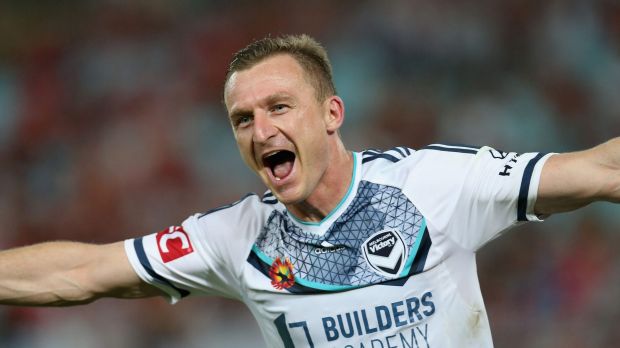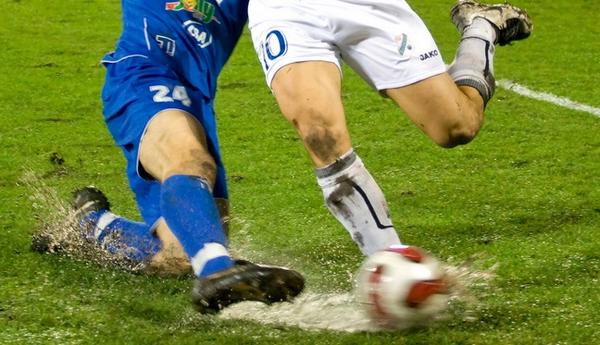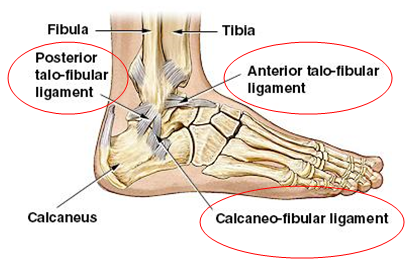Soccer Injuries at Eastern Foot Care discussed off the back of Victory’s win in the Melbourne Derby
As discussed in the past we at Eastern Foot Care Podiatry love all sports. After Melbourne City rolled Melbourne Victory in the first of the
2016 A-League Melbourne Derby clashes we were watching on eagerly for the re-match to see what would happen. As it turned out Melbourne Victory took home the chocolates this time despite Melbourne City fan favourite Tim Cahill finding the back of the net early on in the match.

Following on in the soccer theme Eastern Foot Care Knox Podiatrist Sarah Bowling has prepared some info on common ankle injuries and the best management strategies in the event of an injury
ANKLE SPRAINS IN SOCCER PLAYERS
As the most popular sport in the world with 3.5 billion spectators and 265 million male and female participants Soccer players run the risk of serious injury, especially to the feet and ankles. There is also a body of 5 million referees and umpires that are active throughout the game and can sustain injuries too.
Most soccer injuries involve the ligaments of the ankle which are like thick rubber bands that hold the bones together and allow the ankle to move upwards (flexing at the ankle) or downwards (pointing toes) which gives a powerful soccer kick.
Whether it comes from lack of appropriate warm up, previous injury, training errors, fatigue, pressure from defenders or playing surface, all ankles injuries should be treated accordingly and your Podiatrist is a good place to start.
First the ankle sprain needs to be classified as an inversion, eversion or high ankle sprain.
Inversion ankle sprains are the most common and occur when the outside ligaments are overstretched. Most commonly involving Anterior Talofibular Ligament. Players often sustain contact injuries in which the player with the ball is challenged by a defender who slides into the foot and forces the ankle to roll outwards. FIFA, which is the governing body of Soccer will penalise these unsafe tackles with an automatic red card and dismissal from the field
In other instances not involving defenders, players may be landing from a jump after headbutting the ball and land on another players foot uneven surface of the grass field.
Immediatly after injury there will be tenderness and swelling on the outside of the ankle with possible bruising.
Eversion ankle sprains are less common and involve the Deltoid ligament complex on the inside of the ankle being over- stretched. The ligaments on the inside of the ankle are usually stronger than those on the outside however in a high impact, fast moving, rapid change in direction soccer game the feet a
nd ankles conform to many different angles and place large amount of pressure on lower limb structures.
High ankle sprains or syndesmotic sprains happen when the foot is planted on the ground and a twisting, turning and rotational movement occurs at the ankle. These are classified as ‘high’ because they occur above the ankle. They affect the ligaments that connect the two lower leg bones; the Tibia and the Fibula.
Once the type of ankle sprain in identified you should then be assessing its severity-
identified you should then be assessing its severity-
- 1st degree- Will have a quick few days recovery. Will immediately have pain and tenderness however the player after a few minutes will be able to walk and then a bit longer after that can hop or run
- 2nd degree- Will present with swelling and ligament laxity plus a limp. The player will be unable to perform a single heel raise, hop on one foot, or be able to jog or run.
- 3rd degree- A snap sound may be heard and will follow with a lot of swelling, tenderness on both the inside and outside of the ankle, large amount of ligament laxity, and inability to put weight on the ankle. A longer recovery period will be needed
Initially, for all ankle sprains PRICE principles should be applied. They are simple, effective and you don’t need a first aid degree to be able to implement them.
P-Protection of the injured player is important. Stop the game, move the player safely to an area out of the way where no further injury can occur.
R-Rest the ankle and don’t try to get back up immediately to play
I-Icing by putting the ice pack into a wet tea towel rather than directly on to the skin will reduce pain and inflammation. Cold therapy should be applied every 10-15 mins for the first 24 hours after injury
C-Compression will help to reduce swelling and prevent further injury plus provide support.
E-Elevation of the ankle to above the heart will allow the swelling to move away from the injury site and return up the leg
Continuing to play after a sprain or in the presence of bruising and swelling can cause further damage and delay healing. Surgery is not often required for ankle sprains. Good conservative management can get the ankle back to full function. After an injury our Podiatrists may suggest a period of taping or bracing and exercises which will support and strengthen the affected ankle and prevent re-occurrence.
There are a lot of clinical tests and signs that your Podiatrist will look for throughout your treatment plan that will give an idea of strength and healing. Such as- Lateral hop test, Rhomberg’s Test and manual muscle testing.
The Podiatrist may give you a referral for an ultrasound Ultrasound for soft tissue examination or an Xray referral to rule out further complications such as a Fibular Fracture of Avulsion Fracture of the 5th Metatarsal.
Eastern Foot Care Sports Podiatrists are adept in the diagnosis and management of all types of foot and ankle injuries. Our Ringwood Podiatry and Knox Podiatry staff can arrange diagnostic imaging and implement a treatment plan, or alternatively refer on for specialist surgical opinion where indicated.
To make an appointment contact our friendly staff at:
Eastern Foot Care Ringwood
27 Wantirna Rd, RINGWOOD
Ph: (03) 9870 1301
Eastern Foot Care Knox
5a/426 Burwood Hwy, WANTIRNA SOUTH (Knox)
Ph: (03) 9887 2233